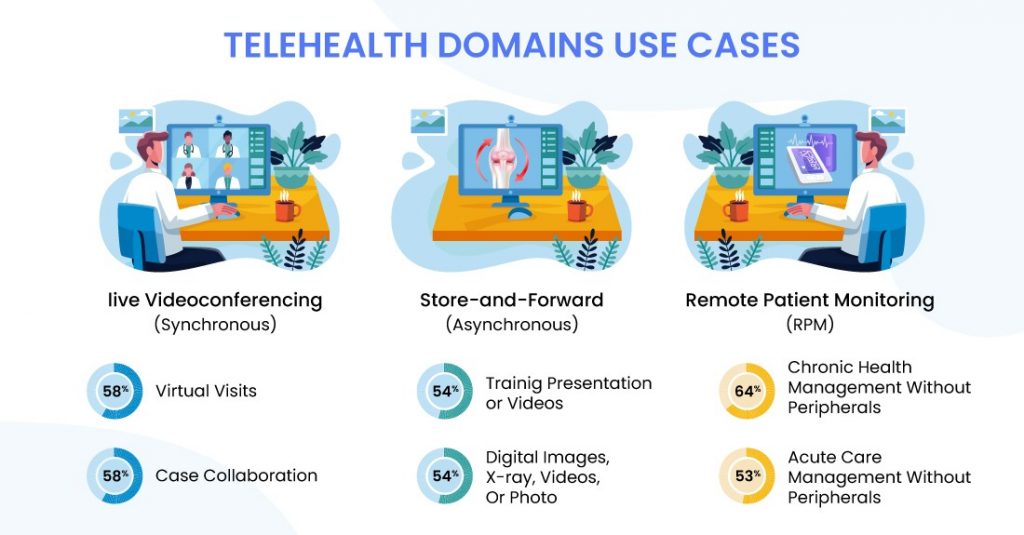Telehealth chatbots are a noteworthy development that has gained increasing notoriety in recent years as technological advancements have altered the healthcare landscape.
These automated conversational agents use artificial intelligence to provide remote healthcare services through the use of nice chat interfaces, enabling users to acquire medical information, receive quick support, and have conversations about their health.
Telehealth chatbots offer a host of benefits that could change patient engagement, accessibility, and effectiveness in the healthcare sector.

Benefits of Telehealth Chatbot
24/7 Availability
Telehealth chatbots, which are accessible 24/7, give patients continual access to medical guidance and assistance.
The availability of care round-the-clock enables patients to seek assistance whenever they do, day or night.
When consumers have urgent medical questions or concerns after regular business hours, these chatbots can step in to offer rapid advice and guidance.
This advantage is particularly crucial when dealing with minor health issues that can be managed without a physical visit to the doctor because it can save patients and healthcare workers time and money.
Increased Access to Healthcare
Telehealth chatbots circumvent geographic restrictions to reach patients in remote or impoverished areas.
In regions with few or no healthcare facilities, these chatbots serve as virtual health assistants, making sure that everyone has access to medical guidance and support wherever they are.
By providing remote consultations, chatbots make it easier for persons living in rural or remote areas to access healthcare services and receive timely guidance on their health concerns.
Quick Triage and Assessment
One of the key benefits of telehealth chatbots is their ability to quickly triage patient complaints and assess their condition.
By asking certain questions and reviewing the responses, these chatbots can swiftly identify the urgency and gravity of a patient’s health condition.
By following this approach, they are able to put patients in the direction of the best healthcare services, whether it be advice on how to take care of oneself, scheduling a non-urgent visit, or suggesting immediate medical help.
Cost-Effective Healthcare
Telehealth chatbots reduce unnecessary visits to doctors’ offices and ERs for mild illnesses, leading to more inexpensive healthcare.
If they can utilise a chatbot to get preliminary advise or gauge the severity of their symptoms, patients may decide without going in person for non-urgent medical treatment.
This saves patients’ time and possibly expensive transportation costs while also assisting healthcare facilities in allocating resources more efficiently for more critical circumstances.
Health Education and Promotion
Telehealth chatbots are crucial for promoting and teaching about health in addition to delivering immediate medical assistance.
Along with individualized health information and recommendations for preventive treatment, they offer guidance on managing chronic conditions.
By including patients in conversations about their health and well-being, chatbots give people the ability to take control of their health.
To encourage healthy lifestyle choices and self-management of chronic conditions, they can provide patients with tailored guidance based on their specific health profiles.
Challenges of Telehealth Chatbots
Privacy and Security Concerns
Telehealth chatbots handle delicate and private medical data, including patient symptoms, medical history, and sometimes even diagnostic information.
To retain patient confidence and adhere to healthcare legislation, it is essential to guarantee the privacy and security of this data.
To safeguard patient data from unauthorized access or breaches, developers must include strong encryption techniques, secure data storage procedures, and stringent access controls.
Limited Clinical Judgment
Telehealth chatbots are quite effective at providing general medical knowledge, but they are unable to use human clinical judgment.
Chatbots might not be able to handle complex medical diseases and scenarios that need careful judgment, sensitivity, and knowledge of the patient’s emotional state.
Chatbots should always advise patients to consult a licensed healthcare provider for an appropriate assessment, diagnosis, and treatment in cases of unsure or significant health conditions.
Misdiagnosis and Liability
Telehealth chatbots could not be able to use their full clinical judgment, which makes them more likely to misdiagnose medical issues.
A chatbot’s incorrect advice or failure to assess the seriousness of a patient’s symptoms could result in a misdiagnosis or a delay in treatment, both of which could be harmful to the patient.
The possibility of legal penalties for the creators or healthcare organizations in charge of the chatbot’s operation raises questions regarding responsibility.
User Interface and Experience
To provide good communication between the chatbot and the patient, telehealth chatbot interface development is essential.
The ability to comprehend and interpret natural language, including different phrasings and questions, should be a feature of chatbot design.
Interactional miscommunication or misunderstanding may result in inaccurate advice or irate users.
Patient engagement and happiness can be increased with the use of an intuitive and well-designed interface.
To improve the chatbot’s functionality and guarantee that it effectively satisfies the needs of its users, frequent user testing and feedback gathering are important.
Integration with Existing Systems
Electronic health records (EHRs) and current healthcare systems can be difficult to integrate telehealth chatbots into.
Maintaining a complete and accurate record of patient encounters, diagnoses, and treatments requires seamless integration.
To create safe data-sharing protocols that adhere to data standards and regulations, developers must collaborate closely with healthcare organizations and IT departments.
Accessing pertinent patient data with the aid of a well-integrated chatbot can improve care coordination and raise the standard of treatment.
FAQs
How accurate are telehealth chatbots compared to real doctors?
Telehealth chatbots can offer helpful information and direction for common health conditions, but they should not be used in place of consulting a doctor.
They are capable of making preliminary assessments but lack the expertise and clinical judgment of real doctors.
It is crucial to seek the advice of a licensed healthcare professional for a comprehensive evaluation of serious or complex medical conditions.
Are telehealth chatbot conversations secure and private?
Yes, trustworthy telehealth chatbot providers are serious about data security and privacy.
To protect patient information and make sure that healthcare laws like HIPAA in the US are followed, they employ encryption and other security measures.
However, users should exercise caution while using chatbot platforms that are not verified and should refrain from disclosing delicate personal data.
Final thoughts
Another key benefit of telehealth chatbots is the provision of affordable healthcare.
These chatbots can aid patients in avoiding unnecessarily visiting clinics or emergency rooms for minor health issues by providing first guidance and self-care instructions.
In addition to saving patients and healthcare professionals important time and resources, this also helps the healthcare system allocate resources more effectively.







